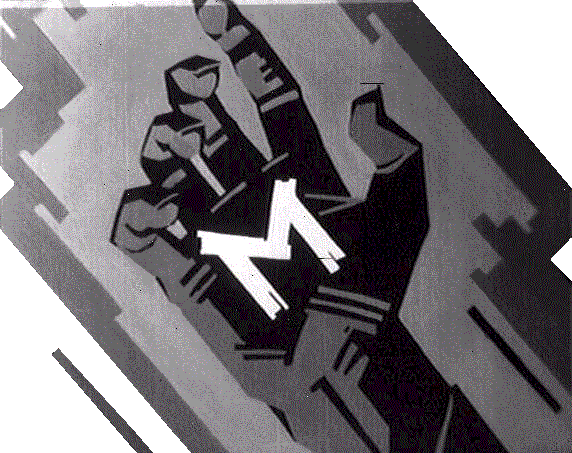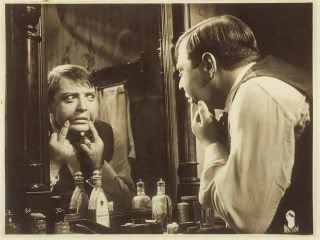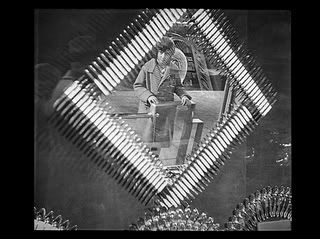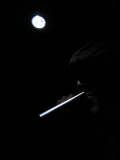
Commentary Breakdown
1. TIME:
a. M begins with a gong, like the ones used during the 1930's to begin a news cast at the top of the hour.
b. One of the first shots is of children playing a game while singing a song of murder to eliminate one another. They are positioned in the fashion of a clock while the child in the middle is the hand of the clock counting down. There are constant recommendations that time is important. It sets up a theme stating, "Time is always ticking." There is a cut from the hunched over murderer shadow to the mother who is hunched over with a knife. This suggests there is a similarity or connection between the two. Later on we discover that the murderer is an ordinary man with an occasional problem of homicide.
c. Later on mother becomes disturbed by a cuckoo clock. It is a reminder that Elsie is late and also foreshadows evil coming.
d. A little girl asks a man on the street "can you please tell me the time." A man of authority then quickly questions him. This plays on the social theme of class. The composition of the frame goes to exaggerated point of view shots. Extreme low to high shots and visa versa show the class differences.
e. An obsession with time is shown when an officer calls to a higher power for the precise time. He then lays out a dozen watches on the table to correct them. The watches are not off by minutes, only seconds.
2. SHADOW:
a. The murder is introduced to the audience just by an outline. As he walks up to Elsie, the shadow highlights and obscures him on the wanted poster.

b. Important characters are introduced in shadow such as the murderer and Lohmann, who both wear bowling hats.
c. The criminal gang’s shadows are captured at a meeting just before their significant capture. The shadows enhance their important role.
3. EDITING:
a. During the same time of the murder, Elsie's mother receives her new installment of serial fiction. It is a comic that has murders that rhyme those in the world of the film. The postman calls the comic "thrilling, stimulating and sensational."
b. There is a sequence that begins at the criminals' base. The criminal leader is expressing the importance of stopping the murderer. He uses an arm gesture that the chief of police also uses repeatedly while giving a similar speech. The editing sequence creates a parallel of the two sides. The sequence is used to under score the murderer's power and makes the opposite parties forget their differences.
4. REFLEXION:
a. During the investigation scene there is a cut to the murderer in front of a mirror. There is a voice over of the investigator analyzing the letter who describes the murderer as one who displays "unmistakable signs of madness." The murderer is plays with his face. He is described by the community as a monster and tries to view himself as one.

5. SPACE:
a. The garden scene was set to display a public area that the police were combing for clues. This was a studio shot where space was limited but designed with beauty and efficiency.
6. ISSUES:
a. There is a scene where two witnesses are being questioned and have two conflicting answers. An actual problem during the early 1900's was reliability of witnesses. It represents cities where there are thousands of voices constantly bringing mass confusion. The city is a source of conflicting energies and chaos. This is where Lang shows that administration must do there part to secure, control and monitor social irritations.
7. SOUND:
a. Sound was only used in 2/3 of the film for a few reasons. First, licensing the sound equipment was expensive. Second, the silence of several scenes adds dread. After we learn that the murderer is out on the street, Elsie bounces her ball by herself up a dark street. Also, when the police raids go on, there is silence until two whistles can be heard off screen. This asks the viewer, "What did they find?"
b. During the cafe scene no ambient sound is heard during conversation between Beckert and the waiter. Lang believed that you do not pay attention to the ambience while engaged.
c. Expressionistic sounds are heard through out the film, but the sources are off screen. This can be seen in the cafe when Beckert is plugging his ears and whistling is heard. Lang uses sound to describe what the characters are feeling and thinking, not always diegetic sounds.
8. COMPOSITION:
a. During a pub raid, there is a point of view shot looking down the stairs. It captures a brick spiral staircase arched over by concrete. The frame is filled with distressed and worried faces. This gives the impression of a trap as people run up them only to be stopped and pushed back by the police.
b. There is a beautiful medium dolly shot at the underground bar. It is of the inventory gathered by the people trapped and questioned. The entire frame is filled with knives, guns, watches, cigarette cases, etc. It is stylistic to German Expressionism in that it takes a raw and sober view at the world.
c. During the police meeting and criminal meeting, smoke is used to diffuse any distinction between the two groups.
d. Beckert's obsession of knives becomes apparent at a shop window when he is framed by a reflection of knives. His evil obsession becomes clearer when knives frame a little girl.


e. After the knives, the little girl walks by a shop window next to a phallic arrow bobbing inside. The camera then follows her to where she meets her mother. The framing and voyeuristic camera style support Beckert's perversion.
f. Walking behind a thin wall of plants Beckert becomes barely visible. Now the roles have reversed and the viewer is now stalking. The camera then changes perspective to that of a trailing detective. This POV shot peaks through the foliage.
g. When the blind man tells the boy that the one whistling is the murderer, there is a medium shot of the two. They are both looking out of the frame to the left. This builds tension to the pursuit because the view wants the blind man to speak quickly and the boy to chase immediately.
h. In a criminal meeting, the leader is dressed in a leather coat, bowler hat and leather gloves. Determination and calculation is expressed with hand gestures. His rigid hand movement during his speech, which is centered in the frame suggests control, power and potential violence.
i. After extracting Beckert from the building, the criminals walk through the frame leaving the viewer with a still picture of the empty lobby. It is followed with still frames of the head watchman bound on the ground, two security guards tied up against a wall, doors missing the entire handle area, broken walls of the storage area, and a cement hole through an upper floor.
It is the final showing of the building that has just been violated. These stills show acts of violence against property and men.
j. Lang played with circles in the scene when the police find the last criminal is the building. His face pops through the circular hole as when the police arrive. When they ask him to come up he sits with his feet dangling in the hole as a zoom out reveals several police men creating a larger circle.
k. The very unflattering shot of Lohmann angled from under a desk is used to show that he is in a low point of the investigation. Even though he has captured a criminal there is no evidence of motives. The shot is followed by him drinking bad coffee, which is symbolic to his mood.
l. A second use of stills is shown when Lohmann reviews the statement given by the criminal. It covers what the viewer already knows but this time it represents all the facts that the investigators have gathered.
m. The longest pan of the film is when Beckert views the underground. This is the area where the community has been waiting to put on his kangaroo court.
9. SMOKING:
a. Smoking is a dirty habit that the city folk, criminals, businessmen, and police exude. Nervous people with pressure and stress were often seen as habitual smokers. There was also a culture of nervousness found in the trenches during Word War I.
10. INFLUENCES:
a. Cutting from criminal serial killing (in the film world) to fighting and killing in the World War I trenches never made it out of Lang's film journal.
b. A German police chief invented the mörd auto (murder auto,) which was a vehicle equipped with all the tools and materials needed to investigate a murder scene. Eventually a new homicide division, Inspektion Mörd (also known as M. Division,) was created. This gives many clues to where Lang may have dug up the title.
c. The title was originally Murderer Among Us. It was said to be change because the Nazis may take it to personal. But the press release stated a change for marketing reasons. Several other films being released at the same time contained "murder" in the title.
d. Lang pulled much of the material from the Peter Kürten's crimes of 1929. Articles were produced in detail of the detection, failures and successes of the case. Lang also researched criminal effects on communities. Kürten was known as "The Vampire of Düsseldorf" due to his violent sexual crimes against children and adults. He was eventually caught and charged with 80 offenses. He was sentenced and executed by guillotine in Köln on the morning of July 2nd, 1932.
e. In an interview after the release of M, Lang stated "Who isn't influenced Brecht." Bertolt Brecht employed the use of techniques that remind the spectator that the play is a representation of reality and not reality itself.
a. M begins with a gong, like the ones used during the 1930's to begin a news cast at the top of the hour.
b. One of the first shots is of children playing a game while singing a song of murder to eliminate one another. They are positioned in the fashion of a clock while the child in the middle is the hand of the clock counting down. There are constant recommendations that time is important. It sets up a theme stating, "Time is always ticking." There is a cut from the hunched over murderer shadow to the mother who is hunched over with a knife. This suggests there is a similarity or connection between the two. Later on we discover that the murderer is an ordinary man with an occasional problem of homicide.
c. Later on mother becomes disturbed by a cuckoo clock. It is a reminder that Elsie is late and also foreshadows evil coming.
d. A little girl asks a man on the street "can you please tell me the time." A man of authority then quickly questions him. This plays on the social theme of class. The composition of the frame goes to exaggerated point of view shots. Extreme low to high shots and visa versa show the class differences.
e. An obsession with time is shown when an officer calls to a higher power for the precise time. He then lays out a dozen watches on the table to correct them. The watches are not off by minutes, only seconds.
2. SHADOW:
a. The murder is introduced to the audience just by an outline. As he walks up to Elsie, the shadow highlights and obscures him on the wanted poster.

b. Important characters are introduced in shadow such as the murderer and Lohmann, who both wear bowling hats.
c. The criminal gang’s shadows are captured at a meeting just before their significant capture. The shadows enhance their important role.
3. EDITING:
a. During the same time of the murder, Elsie's mother receives her new installment of serial fiction. It is a comic that has murders that rhyme those in the world of the film. The postman calls the comic "thrilling, stimulating and sensational."
b. There is a sequence that begins at the criminals' base. The criminal leader is expressing the importance of stopping the murderer. He uses an arm gesture that the chief of police also uses repeatedly while giving a similar speech. The editing sequence creates a parallel of the two sides. The sequence is used to under score the murderer's power and makes the opposite parties forget their differences.
4. REFLEXION:
a. During the investigation scene there is a cut to the murderer in front of a mirror. There is a voice over of the investigator analyzing the letter who describes the murderer as one who displays "unmistakable signs of madness." The murderer is plays with his face. He is described by the community as a monster and tries to view himself as one.

5. SPACE:
a. The garden scene was set to display a public area that the police were combing for clues. This was a studio shot where space was limited but designed with beauty and efficiency.
6. ISSUES:
a. There is a scene where two witnesses are being questioned and have two conflicting answers. An actual problem during the early 1900's was reliability of witnesses. It represents cities where there are thousands of voices constantly bringing mass confusion. The city is a source of conflicting energies and chaos. This is where Lang shows that administration must do there part to secure, control and monitor social irritations.
7. SOUND:
a. Sound was only used in 2/3 of the film for a few reasons. First, licensing the sound equipment was expensive. Second, the silence of several scenes adds dread. After we learn that the murderer is out on the street, Elsie bounces her ball by herself up a dark street. Also, when the police raids go on, there is silence until two whistles can be heard off screen. This asks the viewer, "What did they find?"
b. During the cafe scene no ambient sound is heard during conversation between Beckert and the waiter. Lang believed that you do not pay attention to the ambience while engaged.
c. Expressionistic sounds are heard through out the film, but the sources are off screen. This can be seen in the cafe when Beckert is plugging his ears and whistling is heard. Lang uses sound to describe what the characters are feeling and thinking, not always diegetic sounds.
8. COMPOSITION:
a. During a pub raid, there is a point of view shot looking down the stairs. It captures a brick spiral staircase arched over by concrete. The frame is filled with distressed and worried faces. This gives the impression of a trap as people run up them only to be stopped and pushed back by the police.
b. There is a beautiful medium dolly shot at the underground bar. It is of the inventory gathered by the people trapped and questioned. The entire frame is filled with knives, guns, watches, cigarette cases, etc. It is stylistic to German Expressionism in that it takes a raw and sober view at the world.
c. During the police meeting and criminal meeting, smoke is used to diffuse any distinction between the two groups.
d. Beckert's obsession of knives becomes apparent at a shop window when he is framed by a reflection of knives. His evil obsession becomes clearer when knives frame a little girl.


e. After the knives, the little girl walks by a shop window next to a phallic arrow bobbing inside. The camera then follows her to where she meets her mother. The framing and voyeuristic camera style support Beckert's perversion.
f. Walking behind a thin wall of plants Beckert becomes barely visible. Now the roles have reversed and the viewer is now stalking. The camera then changes perspective to that of a trailing detective. This POV shot peaks through the foliage.
g. When the blind man tells the boy that the one whistling is the murderer, there is a medium shot of the two. They are both looking out of the frame to the left. This builds tension to the pursuit because the view wants the blind man to speak quickly and the boy to chase immediately.
h. In a criminal meeting, the leader is dressed in a leather coat, bowler hat and leather gloves. Determination and calculation is expressed with hand gestures. His rigid hand movement during his speech, which is centered in the frame suggests control, power and potential violence.
i. After extracting Beckert from the building, the criminals walk through the frame leaving the viewer with a still picture of the empty lobby. It is followed with still frames of the head watchman bound on the ground, two security guards tied up against a wall, doors missing the entire handle area, broken walls of the storage area, and a cement hole through an upper floor.
It is the final showing of the building that has just been violated. These stills show acts of violence against property and men.
j. Lang played with circles in the scene when the police find the last criminal is the building. His face pops through the circular hole as when the police arrive. When they ask him to come up he sits with his feet dangling in the hole as a zoom out reveals several police men creating a larger circle.
k. The very unflattering shot of Lohmann angled from under a desk is used to show that he is in a low point of the investigation. Even though he has captured a criminal there is no evidence of motives. The shot is followed by him drinking bad coffee, which is symbolic to his mood.
l. A second use of stills is shown when Lohmann reviews the statement given by the criminal. It covers what the viewer already knows but this time it represents all the facts that the investigators have gathered.
m. The longest pan of the film is when Beckert views the underground. This is the area where the community has been waiting to put on his kangaroo court.
9. SMOKING:
a. Smoking is a dirty habit that the city folk, criminals, businessmen, and police exude. Nervous people with pressure and stress were often seen as habitual smokers. There was also a culture of nervousness found in the trenches during Word War I.
10. INFLUENCES:
a. Cutting from criminal serial killing (in the film world) to fighting and killing in the World War I trenches never made it out of Lang's film journal.
b. A German police chief invented the mörd auto (murder auto,) which was a vehicle equipped with all the tools and materials needed to investigate a murder scene. Eventually a new homicide division, Inspektion Mörd (also known as M. Division,) was created. This gives many clues to where Lang may have dug up the title.
c. The title was originally Murderer Among Us. It was said to be change because the Nazis may take it to personal. But the press release stated a change for marketing reasons. Several other films being released at the same time contained "murder" in the title.
d. Lang pulled much of the material from the Peter Kürten's crimes of 1929. Articles were produced in detail of the detection, failures and successes of the case. Lang also researched criminal effects on communities. Kürten was known as "The Vampire of Düsseldorf" due to his violent sexual crimes against children and adults. He was eventually caught and charged with 80 offenses. He was sentenced and executed by guillotine in Köln on the morning of July 2nd, 1932.
e. In an interview after the release of M, Lang stated "Who isn't influenced Brecht." Bertolt Brecht employed the use of techniques that remind the spectator that the play is a representation of reality and not reality itself.


0 Comments:
Post a Comment
<< Home